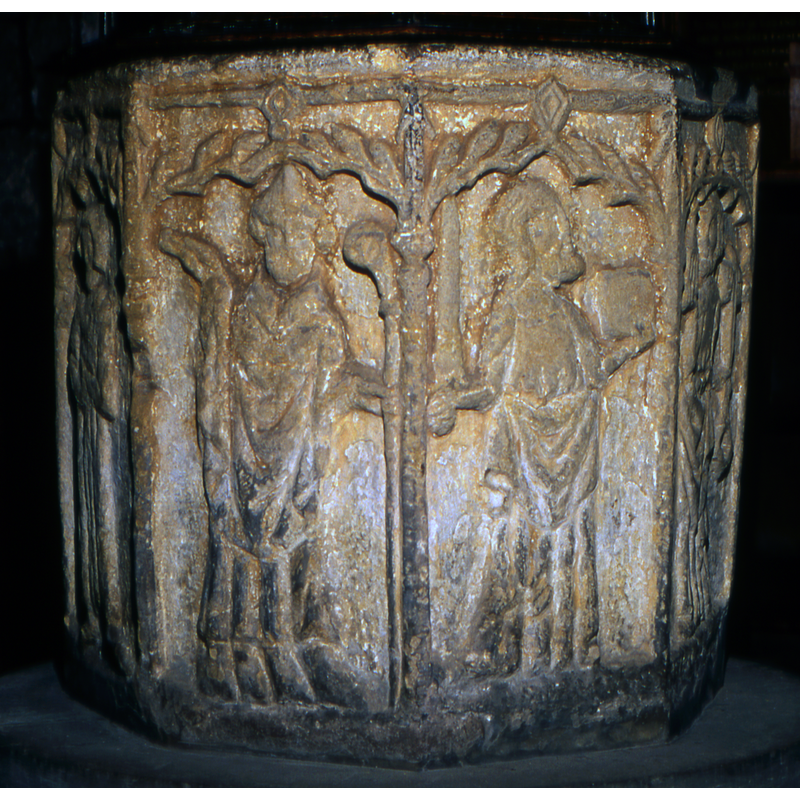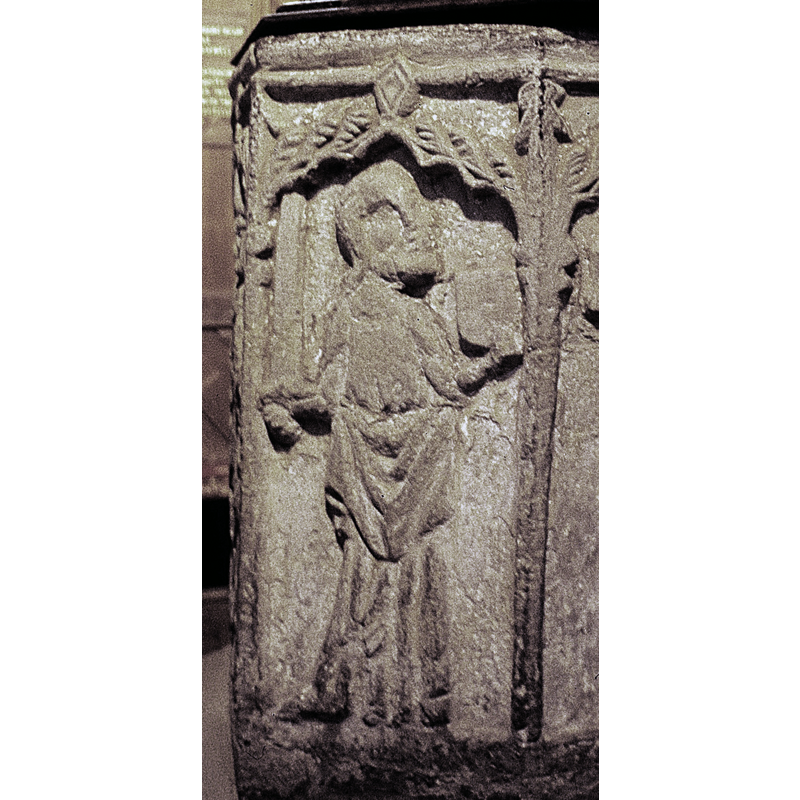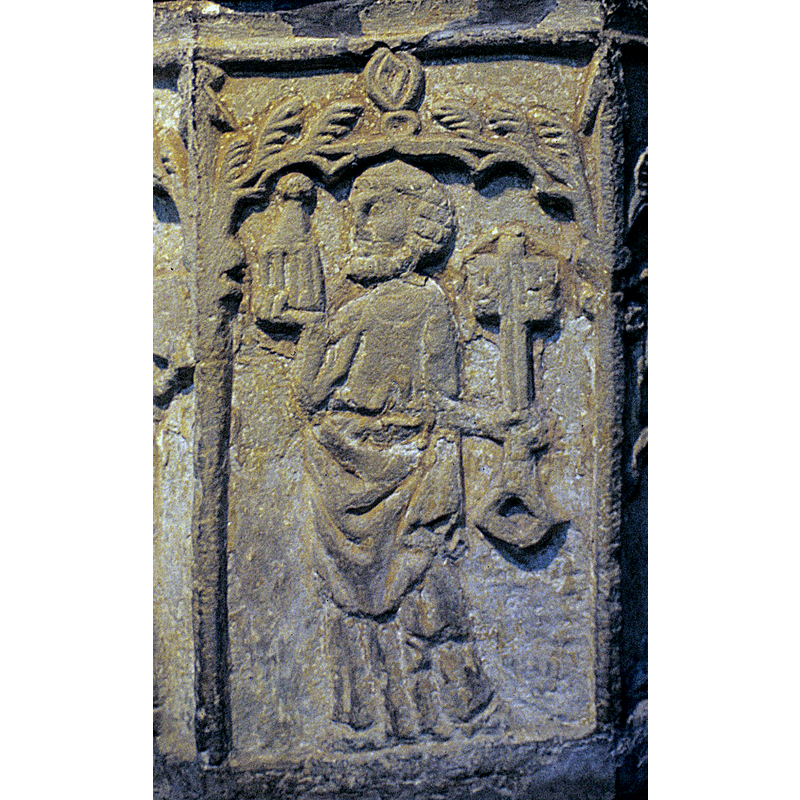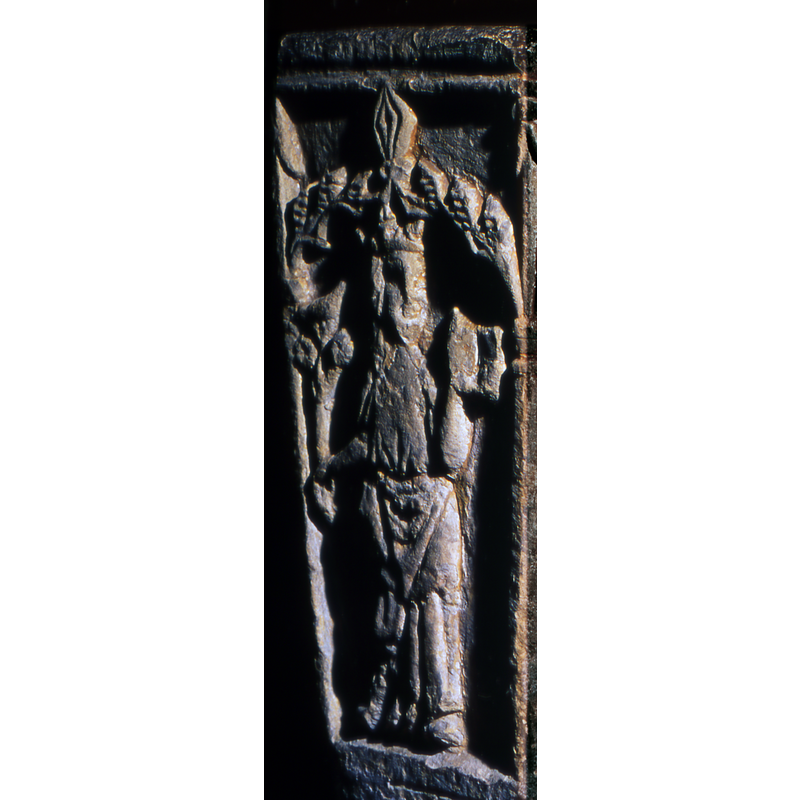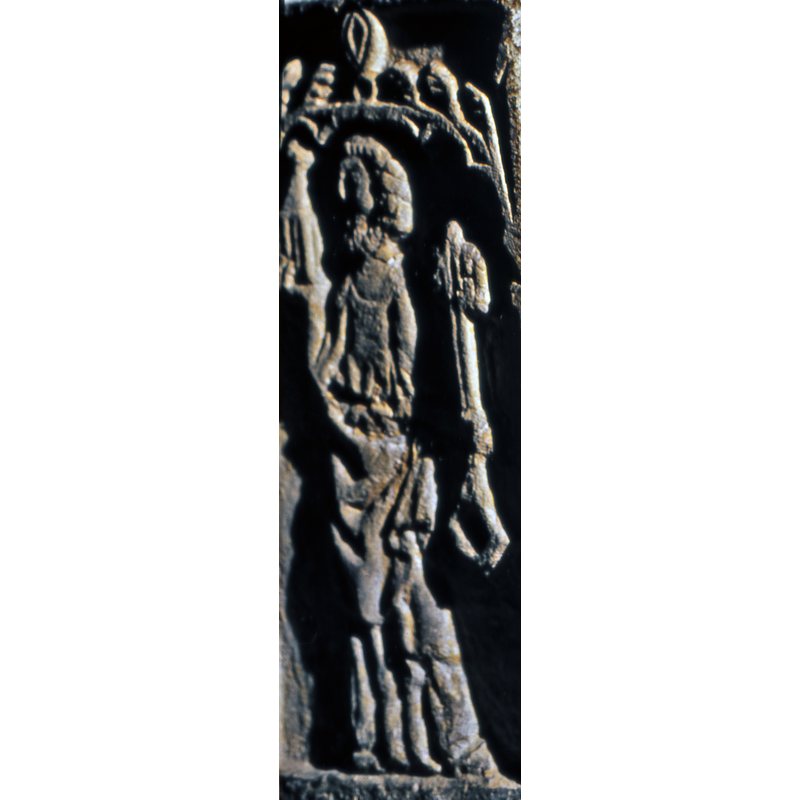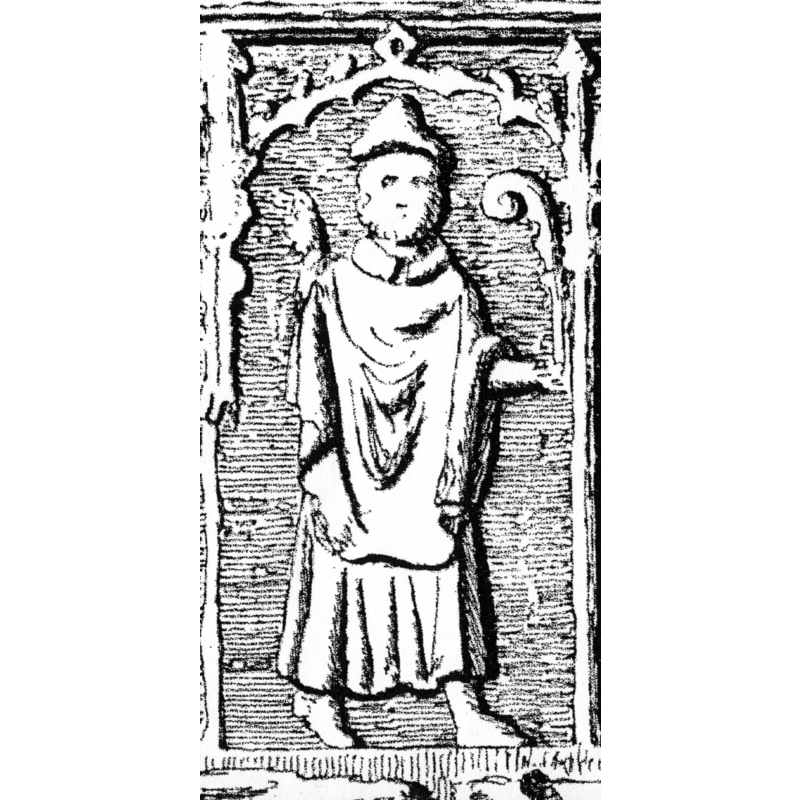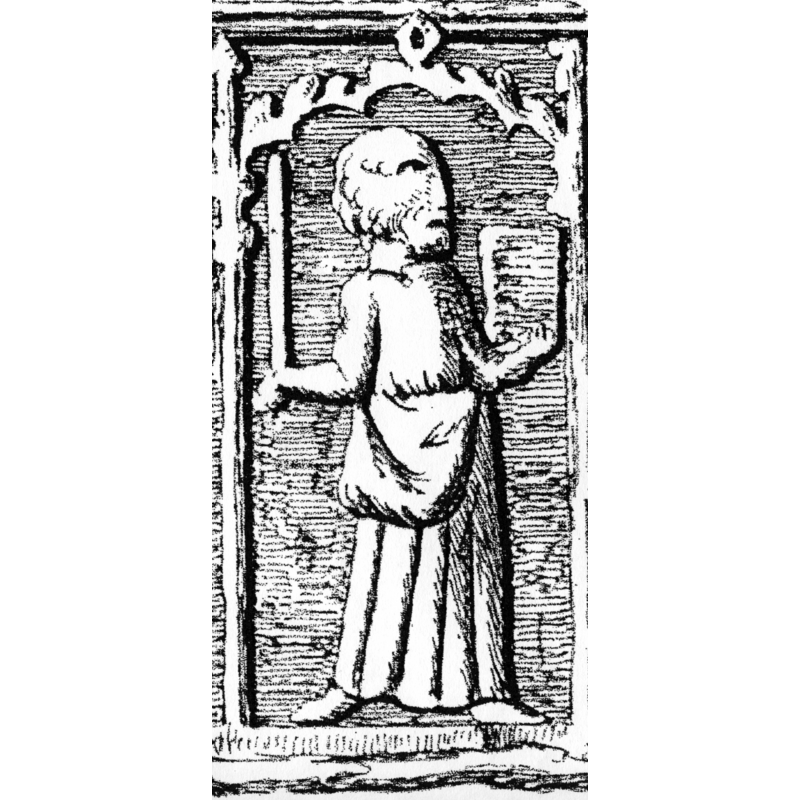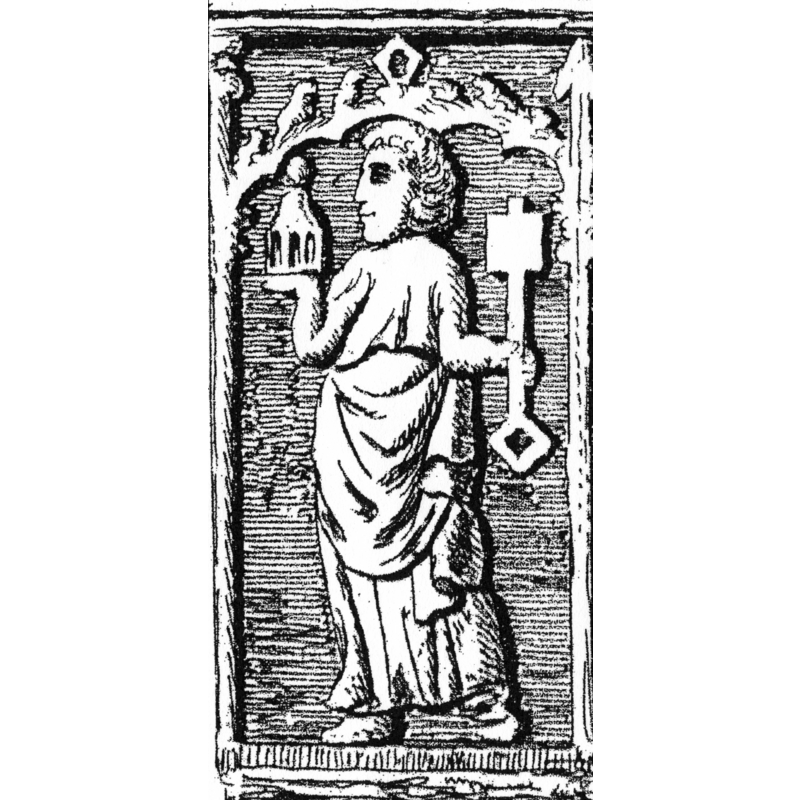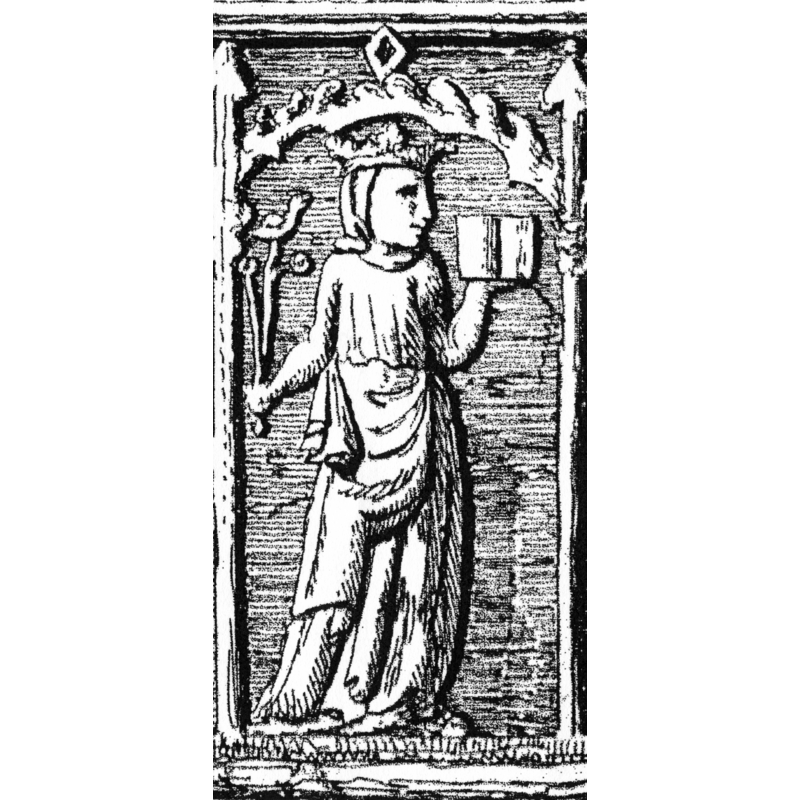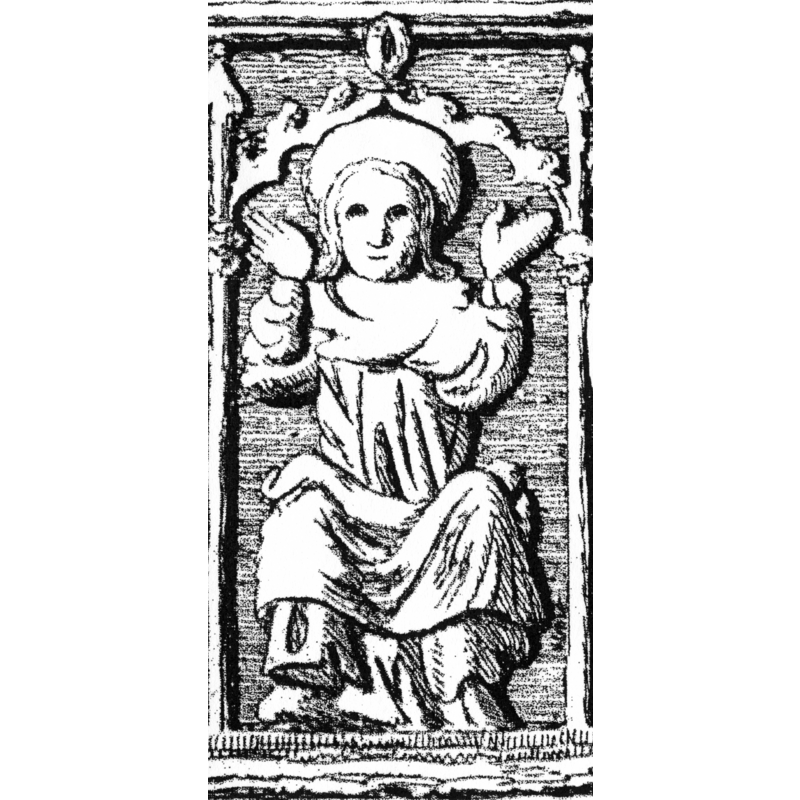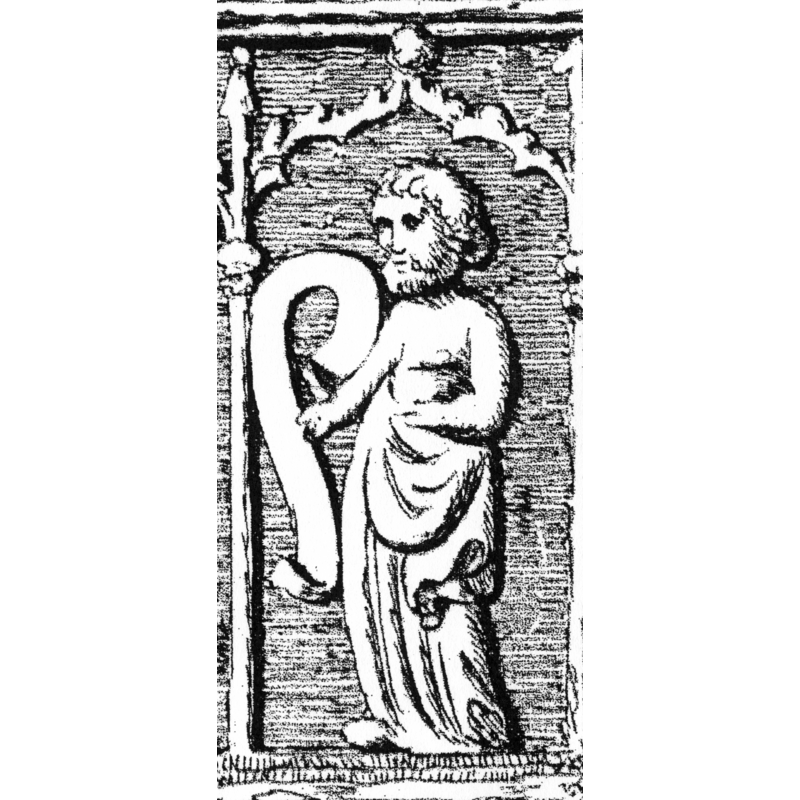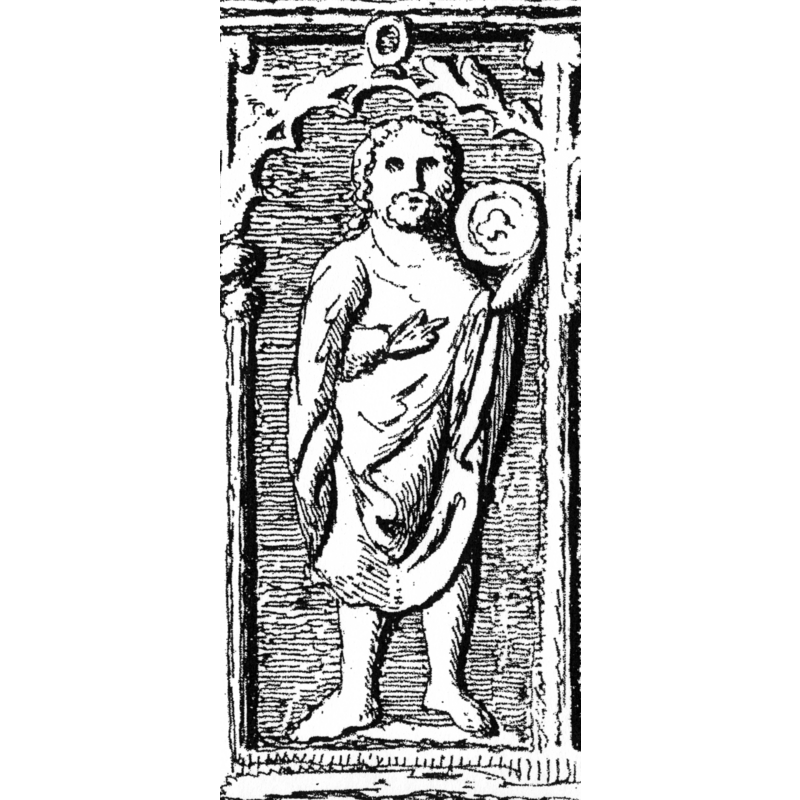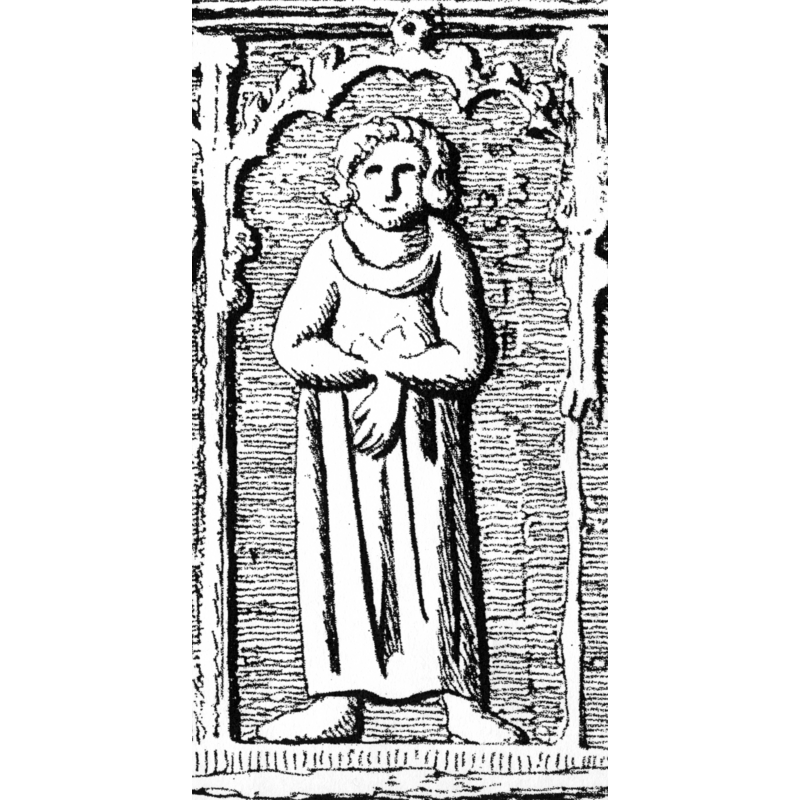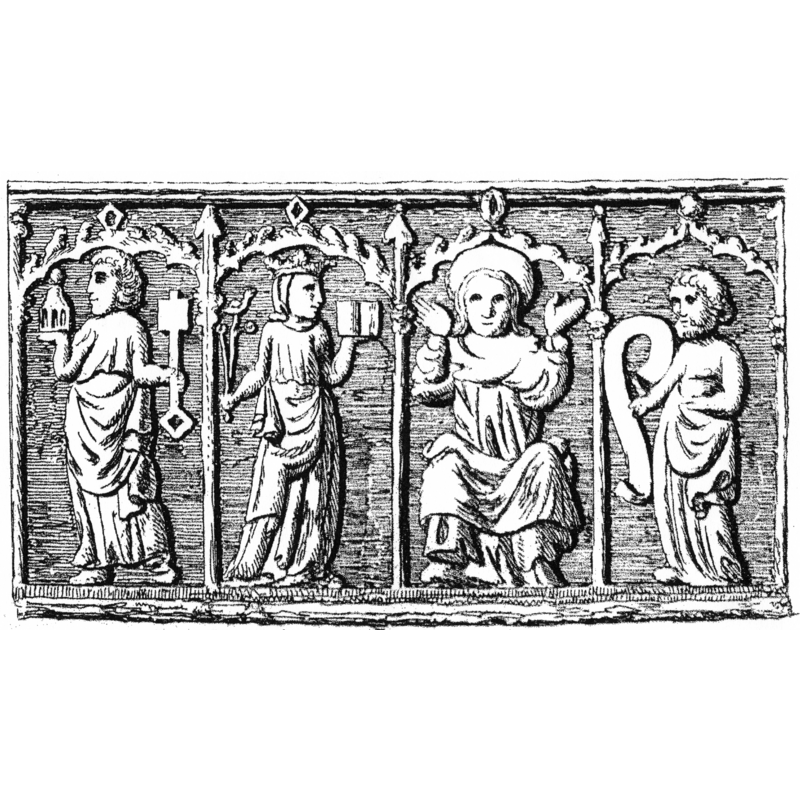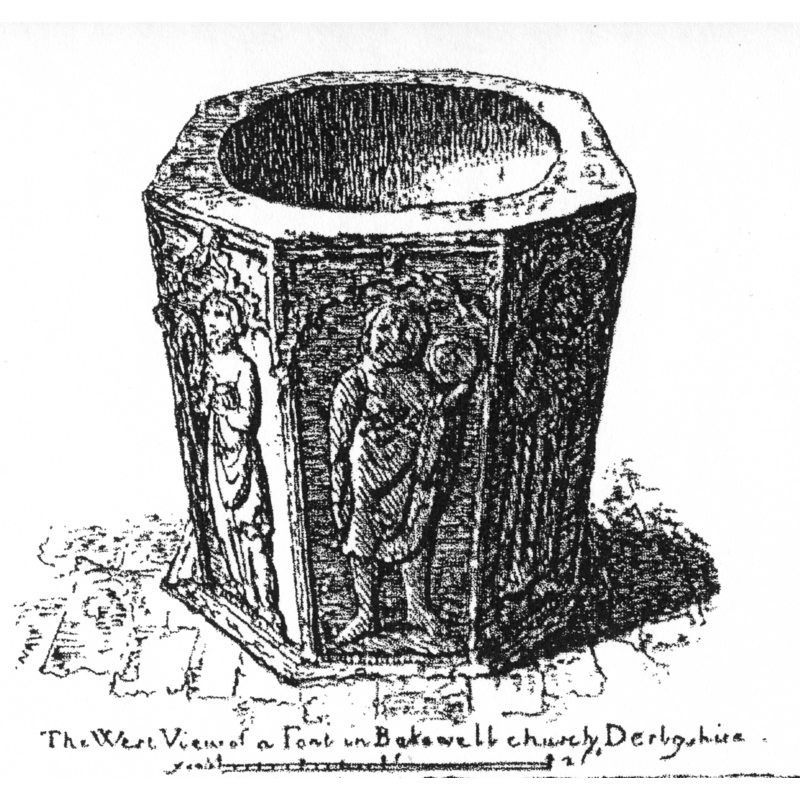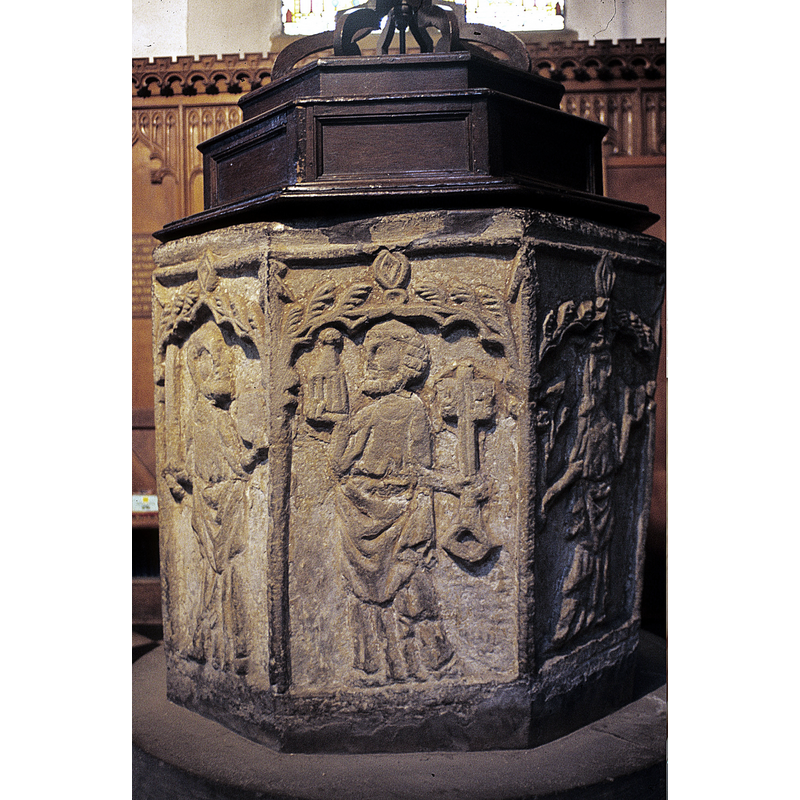Bakewell / Badequella / Badeqvella

Image copyright © Baptisteria Sacra Index, 2023
Results: 24 records
B01: cleric - bishop
B02: Apostle or saint - Apostles - St. Paul
B03: Apostle or saint - Apostles - St. Peter
B04: human figure - male - historical figure - Edward, King of England?
B05: Christ - Christ in Majesty
B06: Apostle or saint - Evangelists - St. John? - with scroll
B07: Apostle or saint - St. John the Baptist?
B08: cleric - priest - with book
Apostle or saint - Apostles - St. Peter - holding 1 key
Virgin Mary - crowned
design element - architectural - arcade - Gothic arches - crocketed arches
view of basin - detail
view of basin - detail
view of basin - detail
view of basin - detail
view of basin - detail
view of basin - detail
view of basin - detail
view of basin - detail
view of basin - iconographic program - detail
view of basin - iconographic program - detail
view of font - west side
view of font and cover
INFORMATION
FontID: 00353BAK
Object Type: Baptismal Font1
Church/Chapel: Parish Church of All Saints
Church Patron Saints: All Saints
Church Location: South Church St, Bakewell, Derbyshire, DE45 1FD, United Kingdom
Country Name: England
Location: Derbyshire, East Midlands
Directions to Site: Located 16 km SE of Buxton on the A6
Ecclesiastic Region: Diocese of Derby
Historical Region: Hundred of Blackwell
Font Location in Church: Inside the church
Century and Period: 14th century, Decorated
Cognate Fonts: The font at Stoke Golding (Leics.), although of different design, has similar ornamentation on the panels of its octagonal mounted basin.
Credit and Acknowledgements: We are grateful to Tim Marlow for his photographs of this font
Church Notes: church originally 920; re-built 12thC; re-built 13thC; re-built 1840
Font Notes:
Click to view
There is an entry for Bakewell [variant spelling] in the Domesday survey [http://domesdaymap.co.uk/place/SK2168/bakewell/] [accessed 20 October 2014], and it reports two priets, a church and church lands in it. The font here is illustrated and described in Carter (1838) [NB: the first edition of this work came out in 1780-1794], where it is stated that "this sculpture is not older than the reign of Edward II", [i.e., 1307+]. Carter identifies some of the figures on the basin sides: "No. 3. seems to represent a bishop with his mitre and crosier; No. 4. perhaps is St. Paul; No. 5. has something like a church in the right hand and a key in the left; No. 6. has in the right hand a flower or branch of a tree on the top of which is a bird, in the left is a book, and on the head is a crown or coronet; No. 7. is a figure seated, with both hands lifted up, and the eyes seem turned towards heaven as if in the act of adoration, and round the head is some appearance of a nimbus; the rest of the figures are all standing; the 8th has in the right hand a scroll in the shape of those in the brass in St. Alban's church, represented in this plate, but if there was ever any inscription on it, it is totally obliterated. It appears by the Saxon Chronicle, that Edward the Elder came from Nottingham to this place, in the year 924, and commanded a town and castle to be built here. Perhaps the building of the church may be referred to this time, No. 6. may represent the King, and No. 5. this church." Noted in Gough (1792) as "adorned with Apostles and Saints". Noted in Lysons (1806-1833) as "large, and in the Gothic style, ornamented with figures, very rudely executed, in bas-relief." In Glover (1831) probably after Lysons. Cox (1875-1877) refers to the earlier opinions on the assigned antiquity of this font but states that the earliest date for the font could be the beginning of the Decorated period at the close of the 13th centuy. Cox (ibid.) further comments on the inscription "Sista (?) Mater" that Lysons claimed to have noted on the font at the time of his visit ca. 1812, and notes that it probably was "on the scroll held by one of the figures that faces south." Cox (ibid. gives his own interpretation of the figures, and indicates that he has little faith in the identifications put forward by Revd. R. R. Rawlings. Romilly Allen (1888) mentions "a fragment of an old font with the name of St. Mark inscribed" in Bakewell. [NB: Cox (ibid) mentions among a number of old fragments in this church, "half of what is described as an old font, and which must have been octagonal when perfect. It is of Early English date. We are more inclined to regard it as a pulpit, but it is so built up with other fragments, that it is difficult now to come to any conclusion. The evangelistic emblem of a winged lion, with the word 'Marcus' carved below it, can plainly be distinguished on one of the faces." -- not entered separately in this Index]. Described in Cox & Harvey (1907) as an octagonal font of the Decorated style with unusual size and treatment. Described in Tyrrell-Green (1928) as a polygonal tub-like font of the Decorated style "where figures of bishopd and saints occupy the arches of a foliated and crocketed arcade". Noted in Pevsner (1978): "Font. Early C14, octagonal, without a separate stem. Whole figures under broad crocketed ogee arches. One of them Christ seated." Described in Karlsson (1981). On-site notes: eight figures are carved on the sides of the basin: 1) Bishop with mitre and crozier; 2)St.Paul? with sword and book; 3) St. Peter; 4) The Virgin? female figure crowned with fleur-de-lis and book; 5) Christ Enthroned in Orant posture; 6) St. John the Evangelist; 7) St. John the Baptist; 8) Priest with a book; the metal lid staples are still visible in the rim; the bowl is lined with lead; the octagonal wooden cover appears to be of the Jacobean style and period; the font is now raised on a two-step plinth. Cox (1887) reports the presence of a large fragment of sculpture found in the porch at his time, "described as an old font, and which must have been octagonal when perfect. It is of Early English date. We are more inclined to regard it as a pulpit, but it is so built up with other fragments, that it is difficult now to come to any conclusion." [NB: no separate entry made in the Index for this object]
COORDINATES
Church Latitude & Longitude Decimal: 53.213396, -1.678311
Church Latitude & Longitude DMS: 53° 12′ 48.23″ N, 1° 40′ 41.92″ W
UTM: 30U 588259 5896825
MEDIUM AND MEASUREMENTS
Material: stone, type unknown
Number of Pieces: one
Font Shape: octagonal (unmounted)
Basin Interior Shape: round
Basin Exterior Shape: octagonal
Drainage Notes: lead lining
Rim Thickness: 12-16 cm*
Diameter (inside rim): 71 cm*
Diameter (includes rim): 95-100 cm*
Basin Depth: 38 cm*
Height of Basin Side: 86 cm*
Font Height (with Plinth): 86 cm*
Notes on Measurements: * BSI on-site
INSCRIPTION
Inscription Notes: [cf. FontNotes regarding a possible inscription on a scroll and/or an inscription if an fragment of an old font]
LID INFORMATION
Date: Jacobean?
Material: wood, oak?
Apparatus: no
Notes: [cf. FontNotes]
REFERENCES
The History and gazetteer of the County of Derby: drawn up from actual observation and from the best authorities [...] the materials collected by the publisher Stephen Glover. Edited by Thomas Noble [...], Derby: Stephen Glover. Printed for the publisher by Henry Mozley and Son, 1831
Allen, J. Romilly, "On the Antiquity of Fonts in Great Britain", XLIV, Journal of the British Archaeological Association, 1888, pp. 164-173; p. 169
Carter, John, Specimens of the Ancient Sculpture and Painting Now Remaining in England: from the Earliest Period to the Reign of Henry VIII [...], London: H.G. Bohn, 1838
Cox, John Charles, 1875-1877
Cox, John Charles, English Church Furniture, New York: E.P. Dutton & Co., 1907
Gough, Richard, "Description of the old font in the Church of East Meon, Hampshire, 1789: with some observations on fonts", X, Archaeologia, 1792, pp. 183-209; p. 188
Karlsson, Lennart, "Hindin mit dem goldenen Geweih", 1981
Lysons, Daniel, Magna Britannia, being a concise topographical account of the several counties of Great Britain, London: Printed for T. Cadell and W. Davies, 1806-1822
Pevsner, Nikolaus, Derbyshire, Harmondsworth: Penguin Books, 1978
Tyrrell-Green, E., Baptismal Fonts Classified and Illustrated, London: Society for Promoting Christian Knowledge: The Macmillan Co., 1928
